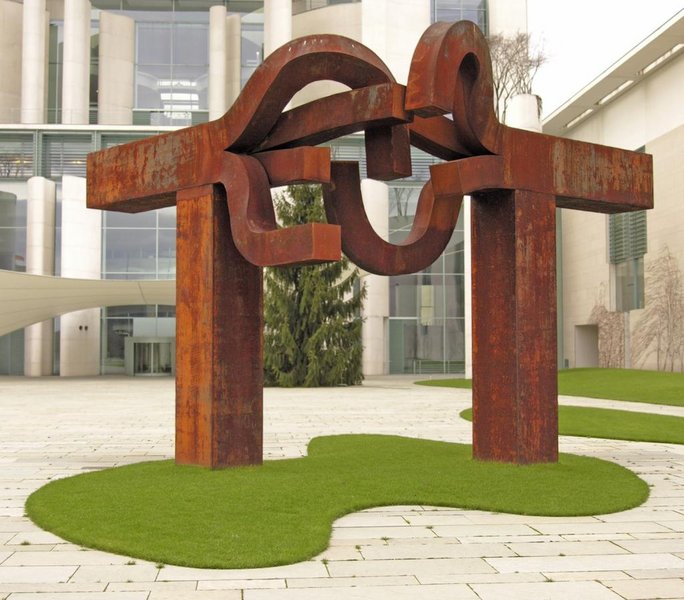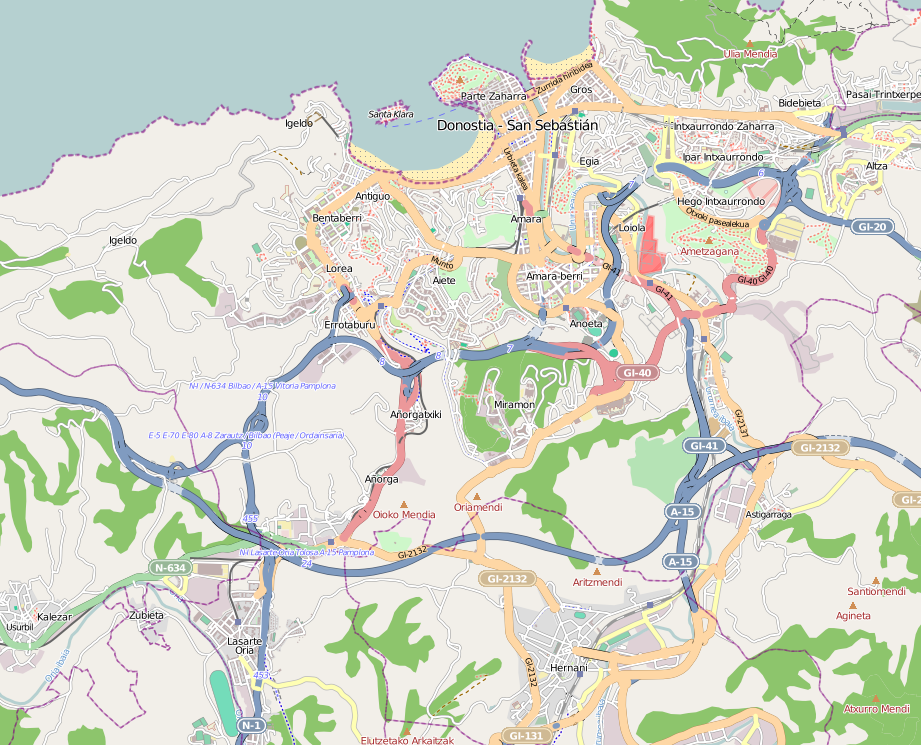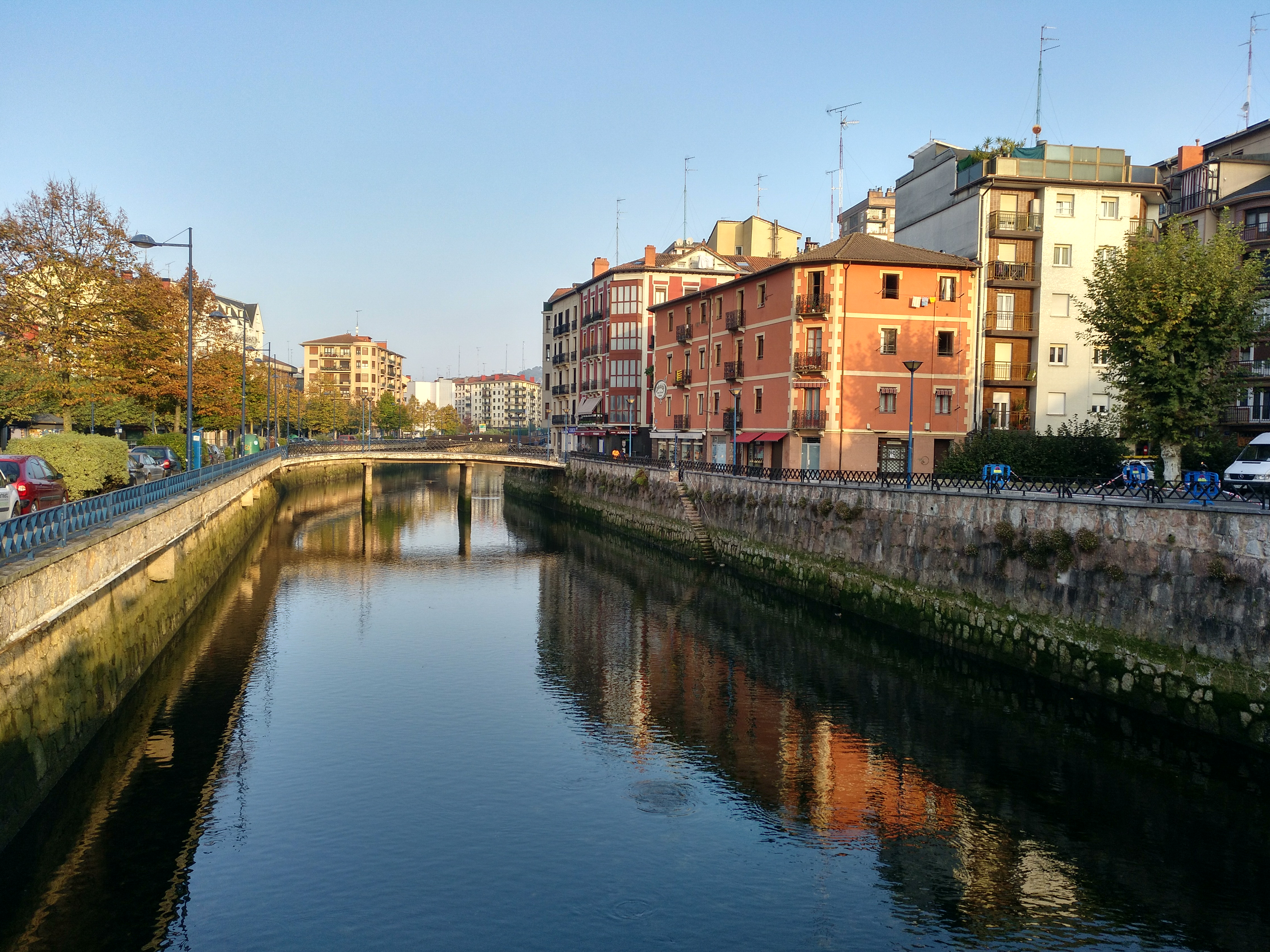|
The Comb Of The Wind
''The Comb of the Wind'' ( eu, Haizearen orrazia XV, es, Peine del Viento XV) is a collection of three sculptures by Eduardo Chillida arranged as an architectural work by the Basque architect Luis Peña Ganchegui. For both, this is one of their most important and well known works. ''The Comb of the Wind'' is located at the western end of La Concha Bay, at the end of Ondarreta beach, in the municipality of San Sebastián, in the province of Guipúzcoa, in the Basque Country of Spain. It is made up of three of Chillida's monumental steel sculptures, weighing 10 tons each, embedded in natural rocks rising from the Cantabrian Sea The Cantabrian Sea; french: Mer Cantabrique, gl, Mar Cantábrico, ast, Mar Cantábricu, eu, Kantauri. is the term used mostly in Spain to describe the coastal sea of the Atlantic Ocean that borders the northern coast of Spain and the southwe .... The work was completed in 1976. In addition to the sculptures, a viewing area was created on the near ... [...More Info...] [...Related Items...] OR: [Wikipedia] [Google] [Baidu] |
Eduardo Chillida
Eduardo Chillida Juantegui, or Eduardo Txillida Juantegi in Basque (10 January 1924 – 19 August 2002), was a Spanish Basque sculptor notable for his monumental abstract works. Early life and career Born in San Sebastián (Donostia) to Pedro Chillida and the soprano Carmen Juantegui on 10 January 1924. Eduardo Chillida grew up near hotel ''Biarritz'', which was owned by his grandparents.Eduardo Chillida Fundación Telefónica, Madrid. Chillida had been the goalkeeper for , San Sebastián's football team, where his knee ... [...More Info...] [...Related Items...] OR: [Wikipedia] [Google] [Baidu] |
San Sebastián
San Sebastian, officially known as Donostia–San Sebastián (names in both local languages: ''Donostia'' () and ''San Sebastián'' ()) is a city and Municipalities of Spain, municipality located in the Basque Country (autonomous community), Basque Autonomous Community, Spain. It lies on the coast of the Bay of Biscay, from the France–Spain border. The capital city of the province of Gipuzkoa, the municipality's population is 188,102 as of 2021, with its metropolitan area reaching 436,500 in 2010. Locals call themselves ''donostiarra'' (singular), both in Spanish and Basque language, Basque. It is also a part of Basque Eurocity Bayonne-San Sebastián. The main economic activities are almost entirely service sector, service-based, with an emphasis on commerce and tourism, as it has long been one of the most famous tourist attraction, tourist destinations in Spain. Despite the city's small size, events such as the San Sebastián International Film Festival and the San Sebastia ... [...More Info...] [...Related Items...] OR: [Wikipedia] [Google] [Baidu] |
Guipuzkoa
Gipuzkoa (, , ; es, Guipúzcoa ; french: Guipuscoa) is a province of Spain and a historical territory of the autonomous community of the Basque Country. Its capital city is Donostia-San Sebastián. Gipuzkoa shares borders with the French department of Pyrénées-Atlantiques at the northeast, with the province and autonomous community of Navarre at east, Biscay at west, Álava at southwest and the Bay of Biscay to its north. It is located at the easternmost extreme of the Cantabric Sea, in the Bay of Biscay. It has of coast land. With a total area of , Gipuzkoa is the smallest province of Spain. The province has 89 municipalities and a population of 720,592 inhabitants (2018), from which more than half live in the Donostia-San Sebastián metropolitan area. Apart from the capital, other important cities are Irun, Errenteria, Zarautz, Mondragón, Eibar, Hondarribia, Oñati, Tolosa, Beasain and Pasaia. The oceanic climate gives the province an intense green colour with little ... [...More Info...] [...Related Items...] OR: [Wikipedia] [Google] [Baidu] |
Spain
, image_flag = Bandera de España.svg , image_coat = Escudo de España (mazonado).svg , national_motto = ''Plus ultra'' (Latin)(English: "Further Beyond") , national_anthem = (English: "Royal March") , image_map = , map_caption = , image_map2 = , capital = Madrid , coordinates = , largest_city = Madrid , languages_type = Official language , languages = Spanish language, Spanish , ethnic_groups = , ethnic_groups_year = , ethnic_groups_ref = , religion = , religion_ref = , religion_year = 2020 , demonym = , government_type = Unitary state, Unitary Parliamentary system, parliamentary constitutional monarchy , leader_title1 = Monarchy of Spain, Monarch , leader_name1 = Felipe VI , leader_title2 = Prime Minister of Spain ... [...More Info...] [...Related Items...] OR: [Wikipedia] [Google] [Baidu] |
Luis Peña Ganchegui
Luis Peña Ganchegui (Oñati, Guipúzcoa, 29 March 1926 - San Sebastián, 2 April 2009) was a Spanish architect. He is considered one of the first to introduce contemporary architecture to Spain. Biography He studied architecture at the Superior Technical School of Architecture of Madrid, graduating in 1959. He began teaching in the same year, first in Barcelona and then in San Sebastian, where he was professor beginning in 1982 and deputy director starting in 1983. Political activity In 1956, Luis Peña became associated with the University Socialist Group (Spanish Wikipedia link) which was led in those years by Víctor Pradera, among others. He was detained for related activities in Pamplona in mid-March 1956, as part of a group that included Juan Benet and Luis Martín-Santos. Career Of his numerous projects, many of the most notable are in the Basque country. His best-known work is the Comb of the Wind, a collaboration with Eduardo Chillida. The two also collabo ... [...More Info...] [...Related Items...] OR: [Wikipedia] [Google] [Baidu] |
Gipuzkoa
Gipuzkoa (, , ; es, Guipúzcoa ; french: Guipuscoa) is a province of Spain and a historical territory of the autonomous community of the Basque Country. Its capital city is Donostia-San Sebastián. Gipuzkoa shares borders with the French department of Pyrénées-Atlantiques at the northeast, with the province and autonomous community of Navarre at east, Biscay at west, Álava at southwest and the Bay of Biscay to its north. It is located at the easternmost extreme of the Cantabric Sea, in the Bay of Biscay. It has of coast land. With a total area of , Gipuzkoa is the smallest province of Spain. The province has 89 municipalities and a population of 720,592 inhabitants (2018), from which more than half live in the Donostia-San Sebastián metropolitan area. Apart from the capital, other important cities are Irun, Errenteria, Zarautz, Mondragón, Eibar, Hondarribia, Oñati, Tolosa, Beasain and Pasaia. The oceanic climate gives the province an intense green colour with littl ... [...More Info...] [...Related Items...] OR: [Wikipedia] [Google] [Baidu] |
Basque Country (greater Region)
The Basque Country ( eu, Euskal Herria; es, País Vasco; french: Pays basque) is the name given to the home of the Basque people. Trask, R.L. ''The History of Basque'' Routledge: 1997 The Basque country is located in the western Pyrenees, straddling the border between France and Spain on the coast of the Bay of Biscay. ''Euskal Herria'' is the oldest documented Basque name for the area they inhabit, dating from the 16th century. It comprises the Autonomous Communities of the Basque Country and Navarre in Spain and the Northern Basque Country in France. The region is home to the Basque people ( eu, Euskaldunak), their language ( eu, Euskara), culture and traditions. The area is neither linguistically nor culturally homogeneous, and certain areas have a majority of people who do not consider themselves Basque, such as the south of Navarre. The concept is still highly controversial, and the Supreme Court of Navarre has ruled against scholarly books that include the Navarre c ... [...More Info...] [...Related Items...] OR: [Wikipedia] [Google] [Baidu] |
Cantabrian Sea
The Cantabrian Sea; french: Mer Cantabrique, gl, Mar Cantábrico, ast, Mar Cantábricu, eu, Kantauri. is the term used mostly in Spain to describe the coastal sea of the Atlantic Ocean that borders the northern coast of Spain and the southwest side of the Atlantic coast of France. It extends from the cape Estaca de Bares in the province of A Coruña, to the mouth of the river Adour, near the city of Bayonne on the coast of the department of Pyrénées-Atlantiques in French Basque Country. The sea borders of coastline shared by the Spanish provinces of A Coruña, Lugo, Asturias, Cantabria, Biscay and Gipuzkoa Gipuzkoa (, , ; es, Guipúzcoa ; french: Guipuscoa) is a province of Spain and a historical territory of the autonomous community of the Basque Country. Its capital city is Donostia-San Sebastián. Gipuzkoa shares borders with the French depa ..., and the French area of Labourd. Notes and references {{notelist European seas Seas of Spain Seas of France Mar ... [...More Info...] [...Related Items...] OR: [Wikipedia] [Google] [Baidu] |
Peine Vientos 2
Peine (; Eastphalian: ''Paane'') is a town in Lower Saxony, Germany, capital of the district Peine. It is situated on the river Fuhse and the Mittellandkanal, approximately west of Braunschweig, and east of Hanover. History A deed from 1130 mentions Berthold von Pagin, ministerialis of Lothair III, emperor of the Holy Roman Empire, who gave his name to the town in the form of Peine. The Peine Castle, no longer existing today, dated to this era or before. The 1201 ''Hildesheim Chronicle'' describes a feud between the bishop Hartbert von Hildesheim and the brothers Ekbert and Gunzelin von Wolfenbüttel. Earl Gunzelin von Wolfenbüttel was the commander-in-chief of the German army and seneschal in attendance of Otto IV, emperor of the Holy Roman Empire. Gunzelin prevailed and won control of Burg Peine and the surrounding area. South of the castle, Gunzelin founded the town of Peine in 1218 or 1220. In 1223, the settlement gained town privileges. Gunzelin's coat of arms has been ... [...More Info...] [...Related Items...] OR: [Wikipedia] [Google] [Baidu] |
Blackpool High Tide Organ
The ''High Tide Organ'' was a tidal organ tall constructed in 2002 as part of "The Great Promenade Show" series of sculptures situated along Blackpool's New Promenade in the UK. It was removed in early 2022. The artwork, described as a "musical manifestation of the sea", is one of a few examples of a tidal organ; others include the San Francisco ''Wave Organ'' and the Sea Organ in Croatia. Design The sculpture was designed by the artists Liam Curtin and John Gooding, and was constructed in concrete, steel, zinc and copper sheet. The harnessing of wave energy, and the sculpting of the concrete and metals, is said to produce a unique interpretation of Blackpool's natural and man-made environments. The instrument is played by the sea at high tide through eight pipes attached to the sea wall. These are connected under the promenade to 18 organ pipes within the sculpture. The swell of seawater at high tide pushes air up the sea-wall pipes and causes the organ pipes to sound. ... [...More Info...] [...Related Items...] OR: [Wikipedia] [Google] [Baidu] |
Sea Organ
The Sea organ ( hr, Morske orgulje) is an architectural sound art object located in Zadar, Croatia and an experimental musical instrument, which plays music by way of sea waves and tubes located underneath a set of large marble steps. History Chaotic reconstruction work was undertaken to repair the devastation Zadar suffered in the Second World War. The frantic reconstruction turned much of the sea front into an unbroken, monotonous concrete wall. The device was made by the architect Nikola Bašić as part of the project to redesign the new city coast (''Nova rive'') and the site was opened to the public on 15 April 2005.Sta-mac, I: ''Acoustical and Musical Solution to Wave-driven Sea Organ in Zadar'', Proceedings of the 2nd Congress of Alps-Adria Acoustics Association and 1st Congress of Acoustical Society of Croatia, pages 203-206, 2005. The waves interact with the organ and create somewhat random but harmonic sounds. The Sea Organ has drawn tourists and locals alike. White ... [...More Info...] [...Related Items...] OR: [Wikipedia] [Google] [Baidu] |
Outdoor Sculptures In Spain ''
{{disambiguation ...
Outdoor(s) may refer to: *Wilderness *Natural environment *Outdoor cooking *Outdoor education *Outdoor equipment *Outdoor fitness *Outdoor literature *Outdoor recreation *Outdoor Channel, an American pay television channel focused on the outdoors See also * * * ''Out of Doors'' (Bartók) *Field (other) *Outside (other) *''The Great Outdoors (other) The Great Outdoors may refer to: * The outdoors as a place of outdoor recreation * ''The Great Outdoors'' (film), a 1988 American comedy film * ''The Great Outdoors'' (Australian TV series), an Australian travel magazine show * ''The Great Outd ... [...More Info...] [...Related Items...] OR: [Wikipedia] [Google] [Baidu] |







